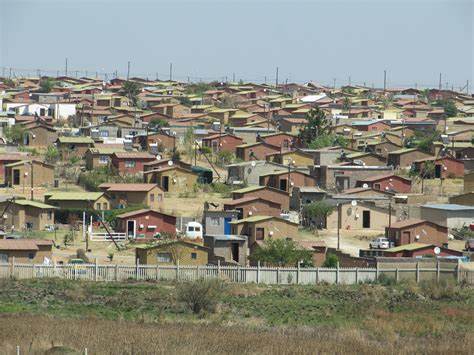Posted on 28 Julie 2019 by volksvryheid

The South African Government, with all their co-partners and
communist shoes, the EFF, ACDP, DA, VF+ (all multi-culture parties),
together with the liberal whites of Dakar, Codesa writers, created more
racism and discrimination with all their B-BBEE legislations, including
the expropriation of property without compensation. The
conservatives are projected as their scapegoats. All members of
parliament are well aware of the real situation in South Africa, because
they are attending those meetings about land, housing and received
Hansards of Parliament. Therefore, it is just impossible that
groups of Blacks or even other coloureds (Khoisan) are landless.
Various immigrants also took over subsidized RDP houses after 1994 –
therefore how many of those houses were sold to the immigrants.
More than 7.6 million blacks have title deed of their properties – more
than a year back! and what has been done about this? nothing.
Die 7.6 miljoen swart titelakte houers
*
The Housing Finance in Africa Yearbook is an annual publication by the Centre for Affordable Housing Finance in Africa (CAHF). The 9th edition of the Housing Finance in Africa Yearbook covers 54 African countries and five regions, and is produced in both English and French versions. Targeted at housing finance practitioners, investors, developers, researchers and government officials, the 2018 Yearbook provides an up-to-date review of practice and developments in housing finance and delivery in Africa, reflecting the dynamic change and growth evident in the market of each country over the past year.
http://housingfinanceafrica.org/countries/south-africa/
***
With a population estimated at 57.73 million in 2018,[1] (no immigrants included here) South Africa’s Gross Domestic Product (GDP) was R4.604 trillion (US$319.9 billion) in 2017, forecast to rise to R4.94 trillion (US$343.3 billion) in 2018.[2],[3] Although South Africa has the 2nd largest economy in Africa (after Nigeria), it ranks 4th in Africa in GDP per capita, after Mauritius, Gabon and Botswana.[4] In recent years, South Africa’s GDP per capita has been decreasing, from a high of US$6 823 in 2013 to US$6 161 in 2017.[5]
Since the establishment of the democratic state in 1994, the government has prioritised an extensive social security and poverty alleviation programme providing social grants, free basic education and health care, government-subsidised housing, and targeted infrastructure investment for basic services. Between 1994 and December 2017, government reports that it has built 2.975 million houses for low income households as part of a massive government-subsidised programme aimed at providing adequate shelter, increasing home ownership, and reversing the spatial divisions which are a legacy of the apartheid regime.[6]
The focus on social security and developmental spending notwithstanding, South Africa remains one of the least equal economies in the world, with a Gini index of 62.8 in 2017. South Africa continues to be plagued by massive unemployment and persistent inequality. The unemployment rate reached 27.2 percent in Q3 2017, the highest since September 2003.[7],[8] The lack of job opportunities is a critical concern for graduates and youth; in 2018, unemployment among youth aged 15-24 (who make up 17 percent of the population) was 32.4 percent.[9]
Economic growth has been insufficient to tackle the key issues of poverty, unemployment and inequality. Real GDP growth in 2017 was 1.0 percent, an increase from 0.3 percent in 2016.[10] However, Q1 2018 GDP growth was -2.6%, followed by -0.7% growth in Q2, according to Statistics SA. As a result, South Africa is now technically in a recession (defined by two consecutive quarters of negative GDP).[11] Across the region, average growth in Sub-Saharan Africa is expected to remain moderate at 2.7 percent in 2017, rising to 3.5 percent in 2019.[12]
http://housingfinanceafrica.org/countries/south-africa/
***
In addition to 54 country chapters, regional profiles for Southern, West, North, Central and East Africa discuss trends and provide useful reviews of regional developments, including infographics to present and summarise critical data points, including mortgage lending terms, the price of the cheapest newly built house, and rankings on the ease of doing business.
Of course, the Yearbook is not comprehensive, neither in the scope of countries covered nor the data provided. It is intended as an introduction, with the hopes that the detail provided will whet the appetite for more. CAHF invites readers to provide comment, and share data and what they are doing in housing finance in Africa.
*
Eighty percent of South African households lived in formal dwellings in 2017. Of those living in formal dwellings, 55.5 percent fully own their house and 24.7 percent are renting. A total of 3.1 million households in South Africa live in informal or traditional dwellings (19.1 percent of the total population).[1]
[6] National Department of Human Settlements (2018). HSDG Housing Opportunities and Subsidies Delivered 1994 to 30 December 2017. http://www.dhs.gov.za/sites/default/files/u16/HSDG%20to%20Dec%202017.pdf (Accessed 8 Oct 2018).
***
We are grateful to our sponsors for their support in the publication of the Yearbook:
- African Development Bank Group (AFDB)
- Agence Francaise de Development (AfD)
- First National Bank (FNB)
- FSD Africa
- Habitat for Humanity International
- Home Finance Guarantors Africa Reinsurance (HFGA)
- iBuild
- International Finance Cooperation (IFC)
- National Housing Corporation (NHFC)
- NURCHA
- Open Data Durban (ODD)
- Real Equity for all (REALL)
- Rural Housing Loan Fund (RHLF)
- Select
- Shelter Afrique
- TUHF
- YoManE
- 71point4
- 14 Trees
***
MORE ABOUT RACISM AND LAND REFORM
SA Parliament – land without compensation – traditional leaders
Ramaphosa : “Farmers/Whites are thieves” – accusations > expropriation
Expropriation of land without compensation – South Africa
Dakar 1986-.. – Notes of H Giliomee

